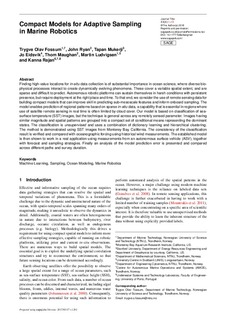| dc.contributor.author | Fossum, Trygve Olav | |
| dc.contributor.author | Ryan, John | |
| dc.contributor.author | Mukerji, Tapan | |
| dc.contributor.author | Eidsvik, Jo | |
| dc.contributor.author | Maughan, Thom | |
| dc.contributor.author | Ludvigsen, Martin | |
| dc.contributor.author | Rajan, Kanna | |
| dc.date.accessioned | 2019-11-29T12:34:24Z | |
| dc.date.available | 2019-11-29T12:34:24Z | |
| dc.date.created | 2019-11-17T11:19:04Z | |
| dc.date.issued | 2019 | |
| dc.identifier.issn | 0278-3649 | |
| dc.identifier.uri | http://hdl.handle.net/11250/2631094 | |
| dc.description.abstract | Finding high-value locations for in situ data collection is of substantial importance in ocean science, where diverse bio-physical processes interact to create dynamically evolving phenomena. These cover a variable spatial extent, and are sparse and difficult to predict. Autonomous robotic platforms can sustain themselves in harsh conditions with persistent presence, but require deployment at the correct place and time. To that end, we consider the use of remote sensing data for building compact models that can improve skill in predicting sub-mesoscale features and inform onboard sampling. The model enables prediction of regional patterns based on sparse in situ data, a capability that is essential in regions where use of satellite remote sensing in real time is often limited by cloud cover. Our model is based on classification of sea-surface temperature (SST) images, but the technique is general across any remotely sensed parameter. Images having similar magnitude and spatial patterns are grouped into a compact set of conditional means representing the dominant states. The classification is unsupervised and uses a combination of dictionary learning and hierarchical clustering. The method is demonstrated using SST images from Monterey Bay, California. The consistency of the classification result is verified and compared with oceanographic forcing using historical wind measurements. The established model is then shown to work in a real application using measurements from an autonomous surface vehicle (ASV), together with forecast and sampling strategies. Finally an analysis of the model prediction error is presented and compared across different paths and survey duration. | nb_NO |
| dc.language.iso | eng | nb_NO |
| dc.publisher | SAGE Publications | nb_NO |
| dc.title | Compact models for adaptive sampling in marine robotics | nb_NO |
| dc.type | Journal article | nb_NO |
| dc.type | Peer reviewed | nb_NO |
| dc.description.version | acceptedVersion | nb_NO |
| dc.source.journal | The international journal of robotics research | nb_NO |
| dc.identifier.doi | 10.1177/0278364919884141 | |
| dc.identifier.cristin | 1748363 | |
| dc.description.localcode | © 2019. This is the authors' accepted and refereed manuscript to the article. The final authenticated version is available online at: https://doi.org/10.1177%2F0278364919884141 | nb_NO |
| cristin.unitcode | 194,64,20,0 | |
| cristin.unitcode | 194,63,15,0 | |
| cristin.unitcode | 194,63,25,0 | |
| cristin.unitname | Institutt for marin teknikk | |
| cristin.unitname | Institutt for matematiske fag | |
| cristin.unitname | Institutt for teknisk kybernetikk | |
| cristin.ispublished | true | |
| cristin.fulltext | preprint | |
| cristin.qualitycode | 1 | |
